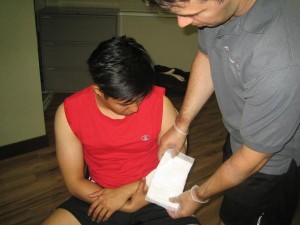Turtles are considered as hardy creatures and have been on earth for millions of years. Some of these turtles thrive in fresh water reservoirs or in the sea as well as species that live on land. The outer side of the body is comprised of the hard shell which protects them from predators and serves as a hiding place when they feel threatened or in danger.
Snapping turtles thrive in shallow bodies of water and when startled, they can attack and bite, similar to a snake. The bites can be vicious but are not poisonous. Take note that a snapping turtle will only bite when provoked or surprised.
An adult snapping turtle ranges in size from 9.5 inches to 15.5 inches with a color that is muddy brown with a bumpy shell. They have a visible tail and a triangle head. Snapping turtles have strong and sharp jaws, but they do not have teeth or fangs but capable of breaking the skin and sometimes cut human fingers and toes.
A close look on snapping turtle bites

- The bite of a snapping turtle typically occurs on the fingers or the toes but sometimes they can bite an individual on the face if the turtle is held close to the face and mouth.
- The bites of this turtle can be a small bruise or a large bite with skin that is torn along with blood oozing from the wound.
- There is swelling and pain around the bite site and the area turns red and inflamed.
- Bacterial infection can develop after a turtle bite. The germs may enter the wound while handling the turtle particularly salmonella which are found in the skin of the turtle and inside the mouth.
- The individual can experience symptoms such as fever, headache, presence of pus and pain at the affected area.
Treatment of a snapping turtle bite
- Keep the individual calm if he/she was bitten by a snapping turtle.
- If the turtle is still attached to the body of the person, avoid pulling it off since it will cause further damage to the bite site. The turtle will eventually release its hold on the skin. The jaws of snapping turtles contract and difficult to remove once they are dead.
- Avoid killing the snapping turtle that is still attached to body of the person.
- First thing to do is clean the wound using a clean gauze or cloth and then rinse the affected area using water.
- Check the bite site if it is superficial or deep
- Clean the affected area with a disinfectant lotion and apply an antibacterial ointment over the area. Apply sterilized gauze and wrap the wound using a bandage.
After treating the bite site using home remedies, it is still best to seek medical help so that medications can be prescribed and even a tetanus shot can be recommended.
